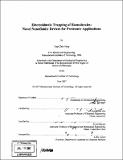| dc.contributor.advisor | Jongyoon Han. | en_US |
| dc.contributor.author | Wang, Ying-Chih, 1977- | en_US |
| dc.contributor.other | Massachusetts Institute of Technology. Dept. of Mechanical Engineering. | en_US |
| dc.date.accessioned | 2008-02-27T22:12:52Z | |
| dc.date.available | 2008-02-27T22:12:52Z | |
| dc.date.copyright | 2007 | en_US |
| dc.date.issued | 2007 | en_US |
| dc.identifier.uri | http://hdl.handle.net/1721.1/40358 | |
| dc.description | Thesis (Ph. D.)--Massachusetts Institute of Technology, Dept. of Mechanical Engineering, 2007. | en_US |
| dc.description | Includes bibliographical references (p. 135-141). | en_US |
| dc.description.abstract | Sample preparation has long been the most important and costly process in bioanalyses. Conventional identification methods involve multiple purification steps combined with mass spectrometry or immunosensing. While well-developed and widely utilized, these methods require extensive human labor and exhibit limited resolving power for low abundance analytes. Due to the shear complexity and abundance variation of biosamples, rapid and ultra-sensitive diagnostic measurements of disease markers are still out of reach. To address this issue, we developed a novel nanofluidic concentrator, utilizing the unique concentration polarization effect of sub 50 nm nanofluidic filters. With the distinct ionic and molecular interaction at the nanoscale, nanofluidic systems can potentially outperform current sample preparation and molecular detection techniques. Aiming to investigate and expand the applications of these techniques, this thesis work involves the design and development of a highly efficient nanofluidic preconcentrator, which can achieve a million fold detectability enhancements without complex buffer arrangements. This thesis also includes an integrated preconcentration-immunosensing device. | en_US |
| dc.description.abstract | (cont.) By manipulating analyte concentrations, this integrated device not only increases the detection sensitivity, but also expands the dynamic range of given antibody-antigen couples. In addition, we also investigated the ion transfer at the micro-/nano-fluidic interface. Depending on the strength of the applied electric field across the nanochannel array, various phenomena such as concentration polarization, charge depletion, and nonlinear electrokinetic flows in the adjacent microfluidic channel can be observed and studied in situ by fluorescent microscopy. In summary, the nanofluidic concentrator we developed in this thesis facilitates sample preparation and detection of biomolecules from complex biological matrices and facilitates a further understanding of nanoscale molecular/fluid/ion transport phenomena by providing a well-controlled experimental platform. | en_US |
| dc.description.statementofresponsibility | by Ying-Chih Wang. | en_US |
| dc.format.extent | 141 p. | en_US |
| dc.language.iso | eng | en_US |
| dc.publisher | Massachusetts Institute of Technology | en_US |
| dc.rights | M.I.T. theses are protected by copyright. They may be viewed from this source for any purpose, but reproduction or distribution in any format is prohibited without written permission. See provided URL for inquiries about permission. | en_US |
| dc.rights.uri | http://dspace.mit.edu/handle/1721.1/7582 | |
| dc.subject | Mechanical Engineering. | en_US |
| dc.title | Electrokinetic trapping of biomolecules : novel nanofluidic devices for proteomic applications | en_US |
| dc.type | Thesis | en_US |
| dc.description.degree | Ph.D. | en_US |
| dc.contributor.department | Massachusetts Institute of Technology. Department of Mechanical Engineering | |
| dc.identifier.oclc | 187991167 | en_US |
